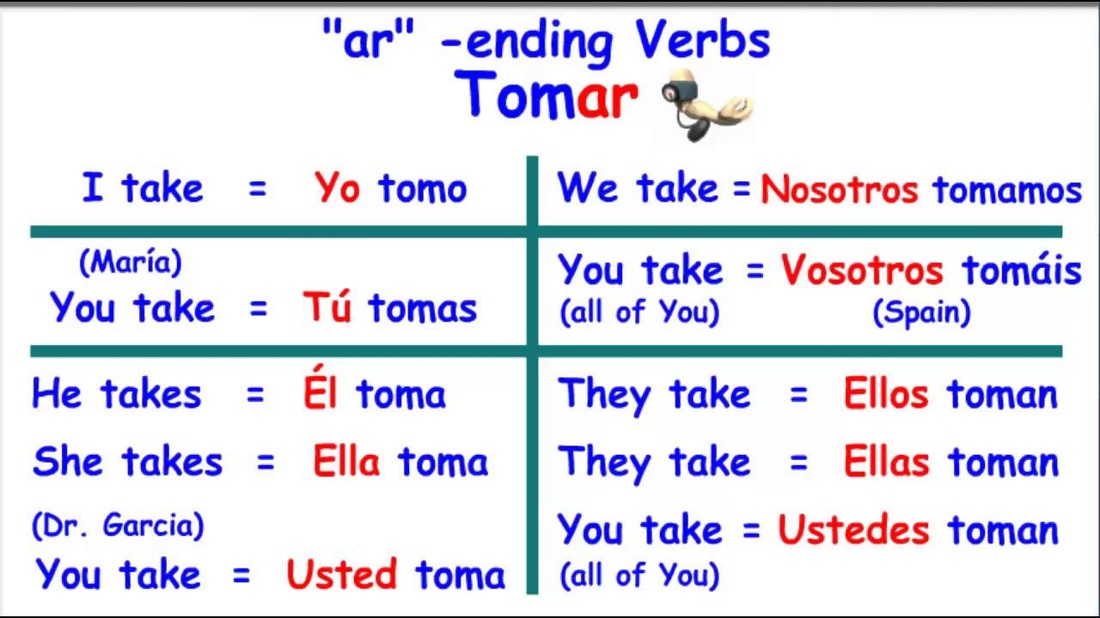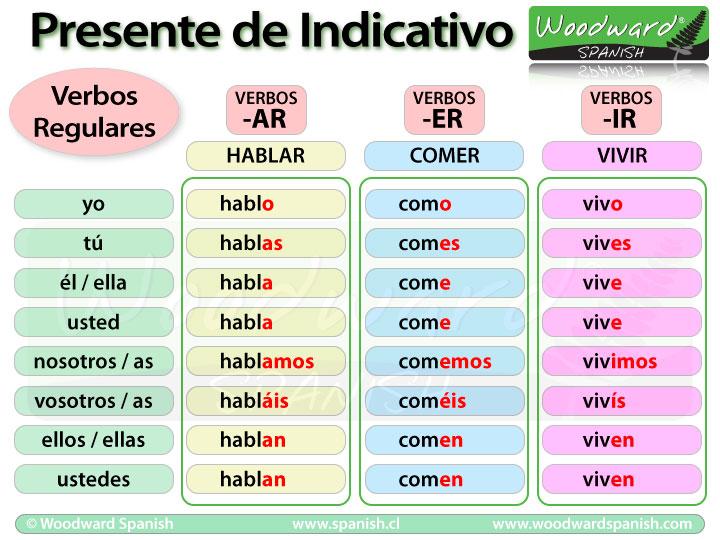Spanish Verb Conjugation in the Present Tense
The most common set of verbs in Spanish and perhaps the most important set of verbs that need to be learned first is the present indicative tense. Although there are conjugations that are easier to learn, the present indicative tense is used the most.
Native English speakers conjugate regular verbs all the time without thinking about it, for the past tense add a “d” or “ed” to the end of a verb, and for the present tense, add an “s” or “es” to indicate a person or thing is performing an action.

BASIC SPANISH CONJUGATION RULES
The conjugation of Spanish verbs is a little trickier than in English. A speaker needs to consider several different tenses, moods, gender and agreement in person according to what needs to be conveyed in the sentence. Spanish verb endings can indicate when the action occurs, and also give the listener a better idea of who or what is performing the action.
The present tense means that the action is occurring now. The indicative mood means that the sentence is a statement of fact. To conjugate a verb in the present indicative, remove the infinitive ending of the regular verb, in this case
-ar,
-er or
-ir, and replace it with an ending that gives an indication as to “the person” that is performing the action of the verb.

REGULAR VERB CONJUGATION
In English and in Spanish, the infinitive form of the verb is the base verb, the standard form of the verb. In the case of English, “to speak,” is the infinitive form of the action of speaking.
The Spanish translation of “to speak,” is hablar. Hablar is a regular verb in Spanish, which means its endings can change in a predictive pattern according to tense, person and mood.
For example,
hablar is the infinitive of a common regular verb ending in
-ar. Remove the
-ar, which leaves the stem of the verb
habl-.
If the person “speaking” in the sentence is in the first person, that would mean the sentence would be conjugated to be “I speak.” In Spanish, when conjugating or changing the stem into a first-person verb, take the stem and add -o, forming the word hablo. “I speak” is Yo hablo.
To say “you speak,” which is the singular, informal, second person, add
-as to the stem, forming the word
hablas. “You speak” is
Tu hablas.
The endings are slightly different for verbs that end in
-er and
-ir, but the principle is the same. Remove the infinitive ending, then add the appropriate ending to the remaining stem.
CONJUGATION OF REGULAR -AR VERBS IN THE PRESENT INDICATIVE TENSE
| Person |
-Ar Ending |
Example: Hablar |
Translation: To Speak |
| yo |
-o |
hablo |
I speak |
| tú |
-as |
hablas |
you (informal) speak |
| él, ella, usted |
-a |
habla |
he/she speak, you (formal) speak |
| nosotros, nosotras |
-amos |
hablamos |
we speak |
| vosotros, vosotras |
-áis |
habláis |
you speak (informal) |
| ellos, ellas, ustedes |
-an |
hablan |
they speak, you (formal) speak |

CONJUGATION OF REGULAR -ER VERBS IN THE PRESENT INDICATIVE TENSE
| Person |
-Er Ending |
Example: Aprender |
Translation: To Learn |
| yo |
-o |
aprendo |
I learn |
| tú |
-es |
aprendes |
you (informal) learn |
| él, ella, usted |
-e |
aprende |
he/she learns, you (formal) learn |
| nosotros, nosotras |
-emos |
aprendemos |
we learn |
| vosotros, vosotras |
-éis |
aprendéis |
you learn (informal) |
| ellos, ellas, ustedes |
-en |
aprenden |
they learn, you (formal) learn |
CONJUGATION OF REGULAR -IR VERBS IN THE PRESENT INDICATIVE TENSE
| Person |
-Ir Ending |
Example: Vivir |
Translation: To Live |
| yo |
-o |
vivo |
I live |
| tú |
-es |
vives |
you (informal) live |
| él, ella, usted |
-e |
vive |
he/she lives, you (formal) live |
| nosotros, nosotras |
-imos |
vivimos |
we live |
| vosotros, vosotras |
-ís |
vivis |
you live (informal) |
| ellos, ellas, ustedes |
-en |
viven |
they live, you (formal) live |
IRREGULAR VERB CONJUGATION
Although most verbs conjugate regularly, the most common verbs in Spanish usually do not. This is similar to English, where the most common verbs such as “to be” and “to go” are also irregular verbs.
PRESENT INDICATIVE CONJUGATIONS OF COMMON IRREGULAR VERBS
| Infinitive |
Translation |
Conjugations |
| dar |
to give |
yo doy, tú das, usted/él/ella da, nosotros/nosotras damos, vosotros/vosotras dais, ustedes/ellos/ellas dan |
| estar |
to be |
yo estoy, tú estás, usted/él/ella está, nosotros/nosotras estamos, vosotros/vosotras estáis, ustedes/ellos/ellas están |
| hacer |
to make |
yo hago, tú haces, usted/él/ella hace, nosotros/nosotras hacemos, vosotros/vosotras hacéis, ustedes/ellos/ellas hacen |
| ir |
to go |
yo voy, tú vas, usted/él/ella va, nosotros/nosotras vamos, vosotros/vosotras vais, ustedes/ellos/ellas van |
| poder |
to be able to |
yo puedo, tú puedes, usted/él/ella puedes, nosotros/nosotras podemos, vosotros/vosotras podéis, ustedes/ellos/ellas pueden |
| ser |
to be |
yo soy, tú eres, usted/él/ella es, nosotros/nosotras somos, vosotros/vosotras sois, ustedes/ellos/ellas son |
| tener |
to have |
yo tengo, tú tienes, usted/él/ella tiene, nosotros/nosotras tenemos, vosotros/vosotras tenéis, ustedes/ellos/ellas tienen |
]]>




